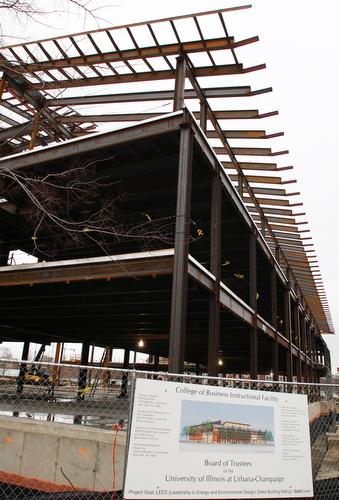New buildings designed to be energy-efficient
Apr 19, 2007
Last updated on May 12, 2016 at 10:26 a.m.
The implementation of the Leadership in Energy and Environmental Design (LEED) Green Building Rating System in campus and city buildings has the potential to bring the University and Champaign-Urbana community into the forefront in sustainability.
Donald Fournier, researcher at the Building Research Council and program manager of the Smart Energy Design Assistance Center, said the LEED system was piloted in the late 90s. The most current system, LEED for New Construction 2.2, came out in 2005.
The new business instructional facility at the corner of Sixth Street and Gregory Drive, the Six Pack residence halls redesign and Lincoln hall renovations are all targeted to meet the criteria for LEED New Construction and Major Renovations ratings.
Sustainability coordinator Matt Malten said the six categories for LEED for New Construction and Major Renovations are sustainable sites, energy and atmosphere, water efficiency, materials and resources, indoor environmental quality and innovations in design.
Get The Daily Illini in your inbox!
Fournier said that buildings are ranked on a system of 69 points. Buildings awarded 26 to 32 points are LEED Certified, those with 33 to 38 points are LEED Silver and those given 39 to 51 points are LEED Gold. Finally, those awarded 59 points and above are LEED Platinum.
Malten said there are seven prerequisites that need to be met before a building can even be considered for a LEED designation. Some of these requirements include meeting certain minimum energy performance requirements and not having ozone-depleting substances in either the central building cooling system or in the dining facilities.
The new business building is targeted for LEED Gold, Fournier said. Features of the building will include photovoltaics, which convert solar energy into electricity, and a green roof, covered with vegetation that will help gather storm water and protect the roof from ultraviolet radiation.
Malten said the new business building is designed to use 40 to 45 percent less energy than a comparably sized and comparably used facility on campus.
The new Six Pack is planned to be a LEED Silver building. The construction will hopefully divert 75 percent of structural waste from a landfill, Malten said.
“That’s very exciting, especially in our area,” he said. “It’s difficult to do.”
Twenty percent of the materials that will make up the building will have recycled content and 20 percent will be from the regional area, usually within a 500-mile radius, he said.
Sustainably harvested wood certified by the Forest Stewardship Council will be used in the construction, Malten said.
He said materials that emit a low level of organic gases will be used for paints and other materials. Malten said the new design of the Six Pack will also make use of solar photovoltaics.
Malten said he knows of two other design projects on campus aiming to achieve LEED ratings, the Faith United Methodist Church, 1719 S. Prospect Ave., and Huntington Tower, 401 S. Randolph St., in Champaign.
“If there’s one thing I could stress why the campus is moving more and more into using LEED as an integrated design tool is because we have seen how it can help facilitate design of buildings that are more energy efficient,” Malten said. “(The) energy issue is something that everybody on campus is trying to help improve.”






